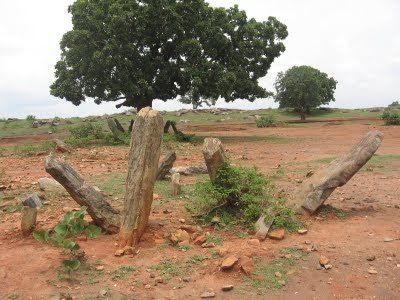Jharkhand state is very rich in ancient and historical sites.
by
Dr. Nitish Priyadarshi
by
Dr. Nitish Priyadarshi


 The above photographs are from Chatra district. Photos were send by Mr. Ujjal Ghosh.
The above photographs are from Chatra district. Photos were send by Mr. Ujjal Ghosh.Different Megaliths site has been identified by different workers in Jharkhand State of India. The sites are mainly concentrated in Hazaribagh, Lohardagga, Singhbhum, Chatra districts etc. Jharkhand state is very rich in ancient and historical sites which need urgent care and importance. Most of the sites in state are still unexplored and needs more research to disclose its mysteries.
Megaliths are the most unfortunate relics of our country's prehistory. Although they are found in almost the entire expanse of the country, still they are not regarded as a source of our prehistory perhaps owing to their tribal origin. But as they are found in almost the entire sacred land of India, these ancient monuments are therefore our truest archaeological heritage.
Megaliths are large stone structures or groups of standing stones which are located at sites in various parts of the would and believed to have religious significance. The term "megalith" means "great stone" which is derived from the Greek words "megas" ('great') and "lithos" ('stone'). However, the general meaning of megaliths includes any structure composed of large stones which includes tombs and circular standing structures. Such structures have been found in Europe, Asia, Africa, Australia, and North and South America.
Their origins and purposes have tantalized experts and ordinary people for centuries. There is a general consensus that many were built in the Neolithic and early Bronze Ages.
Those found in India date from the first centuries of the Christian era. The megaliths on Easter Island, in the South Pacific, probably are contemporary with the Medieval period of Europe.
The general speculation as to their purposes is that megaliths were used for religious activities, burial sites, and astronomical observatories for the sun and other celestial bodies. Some megaliths are said to possess supernatural or electromagnetic forces.
Megalithic burials are found in Northeast and Southeast Asia. They are found mainly in the Korean Peninsula. They are also found in the Liaoning, Shandong, and Zhejiang in China, Kyūshū in Japan,Dong Nai province in Vietnam and parts of India. Some living megalithic traditions is found on the island of Sumba and Nias in Indonesia. The greatest concentration of megalithic burials is in Korea. Archaeologists estimate that there are 15,000 to 100,000 southern megaliths in the Korean Peninsula.
Megaliths were used for a variety of purposes. The purpose of megaliths ranged from serving as boundary markers of territory, to a reminder of past events, to being part of the society's religion.
Amongst the indigenous peoples of India, Malaysia, Polynesia, North Africa, North America, and South America, the worship of these stones, or the use of these stones to symbolize a spirit or deity, is a possibility.
1 comment:
Megalithic Battle grounds
An interesting article by Bekh-Ivanov Dmitri piqued my interest. In it he proposes that the megaliths of Carnac were placed to collect driftwood. In my opinion this is a rather "expensive" means of collecting flotsam in terms of labor and materials involved. Some were quite large and transported from quarries of great distances to their strategic locations. Like the author, I believe the stones had a utilitarian function. Their locations and orientations, I propose, have more to do with defense lines against an enemy who wielded bows and projectile weaponry. Not unlike today the cost of war must have consumed a large portion of the economy. The stones themselves resemble lines of soldiers, standing abreast and in rows. Often the broadest plateau of the stones were oriented to provide the largest surface area of coverage from incoming weapons. Archers could still shoot out between and duck to safety. Angles in dolmens could also then be explained as fox holes in the face of an arched enemy whose weapon would be launched on an arched trajectory. Covered in earth and grass they would have provided camouflaged areas to lay in ambush . Return fire could be shot out from behind metholithic lines which make for formidable shields. Semi-circle configurations provide a cone shaped field of defense against invaders. They were often placed along ridges and slopes of shorelines. Notches and holes might also have been used as sites for aiming and protection simultaneously. In essence they were fox holes and trenches.
Certainly ancient megaliths around the world were used for a myriad of purposes; shelters, calendars, ritual centers, and burial grounds. Perhaps some of the dead had been slain in battle, a fitting resting place for ancient infantry and warriors. It must have seemed that way also to the descendants who sometimes used these sacred stone areas to bury their dead, though they had long forgotten who built them or why they were there. Magical giants might seem a reasonable explanation to the distant children of the builders . Climatic calamities could have pushed increasing hoards of displaced peoples into ancient arable lands. They may have been refugees or aggressors on boats with powerful bows and deadly projectiles. This may have necessitated an expensive military defense response. Refugees of wars in distant places, wars to procure and protect decreasing resources. Cultures with bows have been depicted for ages throughout the world. Further more, if they were designed for ceremony might they not have been a bit more aesthetically pleasing?
Post a Comment